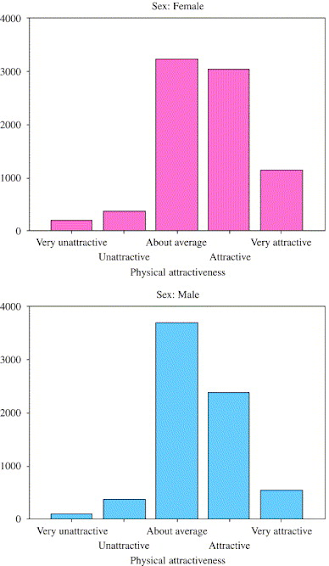An individual's physical attraction to another person plays an active role in reproduction. Markus Jokela ran a study in 2010 for "Physical attractiveness and reproductive success in humans: Evidence from the late 20th century United States". Jokela gathered that very attractive women had 6% more children than their less attractive counterparts. In comparison, men in the lower threshold had 13% fewer children than men with the average number of children. These associations are not fully accounted for but can be a factor in increased marriage probability.
Due to physical attractiveness playing a part in seeking partners, people evolved to seek individuals they are physically attracted to as partners. Physical attractiveness has not been examined directly for increased fertility but does expect attractive people to have higher chances of reproductive success. In a 2007 study, Kanazawa argued that beautiful parents have more daughters than sons because attractiveness is biased toward sex. A female offspring is expected to benefit from genetics by inheriting "attractiveness" compared to male offspring.
Jokela believes that people searching for a partner to have children with are less likely to pick a beautiful partner because beautiful mates are more likely to leave them for another partner.
Predicting adult sociodemographic and fertility outcomes by adolescent attractiveness.
| Predicted outcome | ||||
|---|---|---|---|---|
| Years of marriage | Education | Interbirth interval | Male offspring (%) | |
| Women (n=1244) | ||||
| Not attractive | 16.7(16.1–17.3) | 13.2 (13.0–13.4) | 2.81 (2.57–3.06) | 52.9 (49.4–56.3) |
| Moderately attractive | 17.2(16.2–17.8) | 13.2 (13.0–13.4) | 2.92 (2.67–3.19) | 50.1 (46.5–53.6) |
| Attractive | 18.0(17.4–18.6) | 13.3 (13.1–13.6) | 2.82 (2.58–3.07) | 50.5 (47.2–53.8) |
| Very attractive | 18.0(17.4–18.7) | 13.4 (13.3–13.6) | 3.09 (2.83–3.36) | 53.1 (49.7–56.5) |
| p for linear trend | 0.001 | 0.05 | 0.05 | 0.89 |
| Men (n=997) | ||||
| Not attractive | 23.8 (22.9–24.7) | 14.2 (14.0–14.5) | 3.44 (3.06–3.84) | 53.6(50.3–57.0) |
| Moderately attractive | 24.5(23.6–25.4) | 13.9 (13.6–14.1) | 3.30 (2.94–3.68) | 52.0 (50.0–54.2) |
| Attractive | 25.2(24.3–26.1) | 14.1 (13.8–14.4) | 3.20 (2.85–3.58) | 50.4 (48.2–52.5) |
| Very attractive | 24.9(24.0–25.8) | 13.8 (13.5–14.1) | 3.26 (3.00–3.75) | 48.7(45.5–51.9) |
| p for linear trend | 0.05 | 0.12 | 0.56 | 0.07 |

Sites:
https://www.ncbi.nlm.nih.gov/pmc/articles/PMC3000557/
https://www.sciencedirect.com/science/article/pii/S0022519306003079?casa_token=sxVIupjBIlAAAAAA:5Dksfy_pun8P-11hw3z3Jq5XuLyKOytMFh42Lf7b3IGxv3uzIO0KLgnVezxuGGFcaFJj5_ezBM0
This is wild. This will now be in the back of my head when I get into relationships. I don't want children but the chance of someone breaking up with me based on my physical appearance would be heartbreaking or it can be the opposite.🤷🏽♀️
ReplyDelete